Lamia
Lamia (/ˈleɪmiə/; Greek: Λάμια), in ancient Greek mythology, was a woman who became a child-eating monster after her children were destroyed by Hera, who learned of her husband Zeus's trysts with her. Hera also afflicted Lamia with sleeplessness so she would anguish constantly, but Zeus gave her the ability to remove her own eyes.
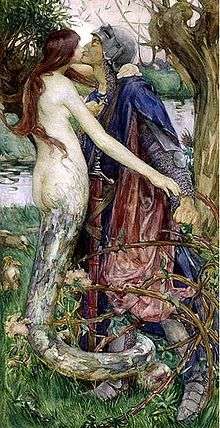
"Lamia" was also used as a bogey word to frighten and discipline children.
In later traditions and storytelling, the lamiai became a type of phantom, synonymous with the empusai which seduced youths to satisfy their sexual appetite and fed on their flesh afterward. A fabulous biography of Apollonius of Tyana defeating a lamia seductress has inspired the poem Lamia by Keats.
The lamia has been ascribed serpentine qualities, which some commentators believe can be firmly traced to mythology from antiquity, and they have found analogues in ancient texts that could be designated as lamiai (or lamiae) which are part-serpent beings. These include the half-woman, half-snake beasts of the "Libyan myth" told by Dio Chrysostom, and the monster sent to Argos by Apollo to avenge Psamathe (Crotopus).
Etymology
A scholiast to Aristophanes claimed that Lamia's name derived from her having a large throat or gullet (λαιμός; laimos).[2] Modern scholarship reconstructs a Proto-Indo European stem *lem-, "nocturnal spirit", whence also comes lemures.[3]
Classical mythology
In the myth, the Lamia was originally a beautiful woman beloved of Zeus, but after Zeus's jealous wife Hera destroyed all her children, or caused Lamia herself to kill her own offspring,[6] she became disfigured from the torment, transforming into a terrifying being who hunted and killed the children of others.[7]
Diodorus Siculus (fl. 1st century BC) gave a de-mythologized account of Lamia as a queen of Libya who ordered her soldiers to snatch children from their mothers and kill them, and whose beauty gave way to bestial appearance due to her savageness. The queen, as related by Diodorus, was born in a cave.[8][9] Heraclitus Paradoxographus (2nd century) also gave a rationalizing account.[10]
Aristotle's Nicomachean Ethics (vii.5) refers to the lore of some beastly lifeform in the shape of a woman, which tears the bellies of pregnant mothers and devours their fetuses. An anonymous commentator on the passage states this is a reference to the Lamia, but muddlingly combines this with Aristotle's subsequent comments and describes her as a Scythian of the Pontus (Black Sea) area.[12][11]
Lamia's eyes
According to one myth, Hera deprived Lamia of the ability to sleep, making her constantly grieve over the loss of her children, and Zeus provided relief by endowing her with removable eyes. He also gifted her with a shapeshifting ability in the process.[13][14]
Diodorus's rationalization was that the Libyan queen in her drunken state was as if she could not see, allowing her citizens free rein for any conduct without supervision, giving rise to the folk myth that she places her eyes in a vessel.[8] Heraclitus's euhemerized account explains that Hera, consort of King Zeus, gouged the eyes out of the beautiful Lamia.[15]
Genealogy
Lamia was the daughter born between King Belus of Egypt and Lybie, according to one source.[lower-alpha 1][13]
According to the same source, Lamia was taken by Zeus to Italy, and that Lamos, the city of the man-eating Laestrygonians, was named after her.[13] A different authority remarks that Lamia was once queen of the Laestrygonians.[17][lower-alpha 2][lower-alpha 3]
Aristophanes
Aristophanes wrote in two plays an identically worded list of foul-smelling objects which included the "Lamia's testicles", thus making Lamia's gender ambiguous.[19][lower-alpha 4] This was later incorporated into Edward Topsell's 17th century envisioning of the lamia.[20]
It is somewhat uncertain if this refers to the one Lamia[21] or to "a Lamia" among many, as given in some translations of the two plays;[22] a generic lamia(s) is also supported by the definition as some sort of a "wild beast" in the Suda.[23]
Hellenistic folklore
As children's bogey
The "Lamia" was a bogeyman or bugbear term, invoked by a mother or a nanny to frighten children into good behavior.[16][24] Such practices are recorded by the 1st century Diodorus,[8] and other sources in antiquity.[13][25]
Numerous sources attest to the Lamia being a "child-devourer", one of them being Horace.[26] Horace in Ars Poetica cautions against the overly fantastical: "[nor should a story] draw a live boy out of a Lamia's belly".[lower-alpha 5][27] Lamia was in some versions thus seen as swallowing children alive, and there may have existed some nurse's tale that told of a boy extracted alive out of a Lamia.[28]
The Byzantine lexicon Suda (10th century) gave an entry for lamia (Λαμία), with definitions and sources much as already described.[29] The lexicon also has an entry under mormo (Μορμώ) stating that Mormo and the equivalent mormolykeion[lower-alpha 6] are called lamia, and that all these refer to frightful beings.[30][31][32]
"Lamia" has as synonyms "Mormo" and "Gello" according to the Scholia to Theocritus.[17]
Other bogeys have been listed in conjunction with "Lamia", for instance, the Gorgo, the eyeless giant Ephialtes, a Mormolyce named by Strabo.[33]
As a seductress
In later classical periods, around the 1st century A. D.,[34] the conception of this Lamia shifted to that of a sultry seductress who enticed young men and devoured them.[35][34]
Apollonius of Tyana
A representative example is Philostratus's novelistic biography Life of Apollonius of Tyana.[35]
It purports to give a full account of the capture of "Lamia of Corinth" by Apollonius, as the general populace referred to the legend.[37] An appartition (phasma φάσμα[38][lower-alpha 7]) which in the assumed guise of a woman seduced one of Apollonius's young pupils.
Here, Lamia is the common vulgar term and empousa the proper term. For Apollonius in speech declares that the seductress is "one of the empousai, which most other people would call lamiai and mormolykeia".[40][36] The use of the term lamia in this sense is however considered atypical by one commentator.[41]
Regarding the seductress, Apollonius further warned, "you are warming a snake (ophis) on your bosom, and it is a snake that warms you".[42][38] It has been suggested from this discourse that the creature was therefore "literally a snake".[43][lower-alpha 8] The empousa admits in the end to fattening up her victim (Menippus of Lycia) to be consumed, as she was in the habit of targeting young men for food "because their blood was fresh and pure".[36] The last statement has led to the surmise that this lamia/empusa was a sort of blood-sucking vampiress.[44]
Another aspect of her powers is that this empusa/lamia is able to create an illusion of a sumptuous mansion, with all the accoutrements and even servants. But once Apollonius reveals her false identity at the wedding, the illusion fails her and vanishes.[38]
Lamia the courtesan
A longstanding joke makes a word play between Lamia the monster and Lamia of Athens, the notorious hetaira courtesan who captivated Demetrius Poliorcetes (d. 283 BC). The double-entendre sarcasm was uttered by Demetrius's father, among others.[lower-alpha 9][45][46] The same joke was used in theatrical Greek comedy,[47] and generally.[48] The word play is also seen as being employed in Horace's Odes, to banter Lucius Aelius Lamia the praetor.[lower-alpha 10][49]
Golden Ass
In Apuleius's The Golden Ass[lower-alpha 11] there appear the Thessalian "witches"[lower-alpha 12] Meroe and her sister Panthia, who are called lamiae in one instance.[52][53][lower-alpha 13][lower-alpha 14]
Meroe has seduced a man named Socrates, but when he plots to escape, the two witches raid his bed, thrust a knife in the neck to tap the blood into a skin bag, eviscerate his heart, and stuff the hole back with sponge.[56]
Some commentators, despite the absence of actual blood-sucking, find these witches to share "vampiric" qualities of the lamiae (lamiai) in Philostratus's narrative, thus offering it up for comparison.[57]
Kindreds
Lamia's possible kindred kind appear in Classical works, but may be known by other names except for isolated instance which calls it a lamia. Or they may be simply unnamed or differently named. And those analogues that exhibit a serpentine form or nature have been especially noted.
Poine of Argos
One such possible lamia is the avenging monster sent by Apollo against the city of Argos and killed by Coroebus. It is referred to as Poine or Ker[58] in classical sources, but later in the Medieval period, one source does call it a lamia (First Vatican Mythographer, c. 9th to 11th century).[59][60]
The story surrounds the tragedy of the daughter of King Crotopus of Argos named Psamathe, whose child by Apollo dies and she is executed for suspected promiscuity. Apollo as punishment then sends the child-devouring monster to Argos.
In Statius' version, the monster had a woman's face and breasts, and a hissing snake protruding from the cleft of her rusty-colored forehead, and it would slide into children's bedrooms to snatch them.[61] According to a scholiast to Ovid, it had a serpent's body carrying a human face.[62]
In Pausanias's version, the monster is called Poinē (ποινή), meaning "punishment" or "vengeance", but there is nothing about a snake on her forehead.[63][64]
One evidence this may be a double of the Lamia comes from Plutarch, who equates the word empousa with poinē.[65]
Libyan myth
A second example is a colony of man-eating monsters in Libya, described by Dio Chrysostom. These monsters had a woman's torso, the lower extremities of a snake, and beastly hands.[66][67][lower-alpha 15] The idea that these creatures were lamiai seems to originate with Alex Scobie (1977),[69] and accepted by other commentators.[70]
Middle Ages
By the Early Middle Ages, lamia (pl. lamiai or lamiae) was being glossed as a general term referring to a class of beings. Hesychius of Alexandria's lexicon (c. 500 A.D.) glossed lamiai as apparations, or even fish.[lower-alpha 16][10] Isidore of Seville defined them as beings that snatched babies and ripped them apart.[10]
The Vulgate used "lamia" in Isaiah xxxiv:14 to translate "Lilith" of the Hebrew Bible.[71] Pope Gregory I (d. 604)'s exegesis on the Book of Job explains that the lamia represented either heresy or hypocrisy.[71]
Christian writers also warned against the seductive potential of lamiae. In his 9th-century treatise on divorce, Hincmar, archbishop of Reims, listed lamiae among the supernatural dangers that threatened marriages, and identified them with geniciales feminae,[72] female reproductive spirits.[73]
Interpretations
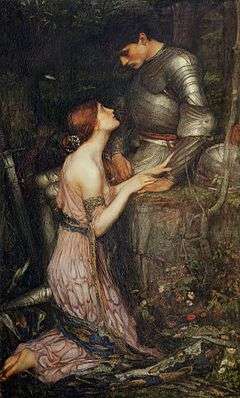
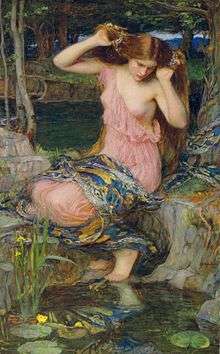
This Lamia of Libya has her double in Lamia-Sybaris of the legend around Delphi, both indirectly associated with serpents. Strong parallel with the Medusa has also been noted. These, and other considerations have prompted modern commentators to suggest she is a dragoness.[74][75]
Another double of the Libyan Lamia may be Lamia, daughter of Poseidon. Lamia by Zeus gave birth to a Sibyl according to Pausanias, and this would have to be the Libyan Lamia, yet there is a tradition that Lamia the daughter of Poseidon was the mother of a Sibyl.[76] Either one could be Lamia the mother of Scylla mentioned in the Stesichorus (d. 555 BC) fragment, and other sources.[78][79] Scylla is a creature depicted variously as anguipedal or serpent-bodied.
Identification as a serpent-woman
Diodorus Siculus (fl. 1st century BC) for instance describes Lamia of Libya as having nothing more than acquiring a beastly appearance.[8] Diodorus, Duris of Samos and other sources which comprise the sources for building an "archetypal" picture of Lamia do not designate her as a dragoness, or give her explicit serpentine descriptions.[80]
In the 1st-century Life of Apollonius of Tyana the female empousa-lamia is also called "a snake",[38] which may seem to the modern reader to be just a metaphorical expression, but which Daniel Ogden insists is a literal snake.[43] Philostratus's tale was reworked by Keats in his poem Lamia,[81] where it is made clear she bears the guise of a snake, which she wants to relinquish in return for human appearance.
Modern commentators have also tried to establish that she may have originally been a dragoness, by inference.[82][83] David Ogden argues that one of her possible reincarnations, the monster of Argos killed by Coroebus had a "scaly gait", indicating she must have had an anguipedal form in an early version of the story,[84] although the Latin text in Statius merely reads inlabi (declension of labor) meaning "slides".[61]
One of the doubles of Lamia of Libya is the Lamia-Sybaris, which is described only as a giant beast by Antoninus Liberalis (2nd century).[85][86] It is noted that this character terrorized Delphi, just as the dragon Python had.[86]
Close comparison is also made with the serpentine Medusa. Not only is Medusa identified with Libya, she also had dealings with the three Graeae who had the removable eye shared between them. In some versions, the removable eye belonged to the three Gorgons, Medusa and her sisters.[87]
Hecate
Some commentators have also equated Lamia with Hecate. The basis of this identification is the variant maternities of scylla, sometimes ascribed to Lamia (as already mentioned), and sometimes to Hecate.[88][79] The identification has also been built (using transitive logic) since each name is identified with empousa in different sources.[43][90]
Stench of a lamia
A foul odor has been pointed out as a possible common motif or attribute of the lamiai. The examples are Aristophanes's reference to the "lamia's testicles", the scent of the monsters in the Libyan myth which allowed the humans to track down their lair, and the terrible stench of their urine that lingered in the clothing of Aristomenes, which they showered upon him after carving out his friend Sophocles's heart.[91]
Modern age
Renaissance writer Angelo Poliziano wrote Lamia (1492), a philosophical work whose title is a disparaging reference to his opponents who dabble in philosophy without competence. It alludes to Plutarch's use of the term in De curiositate, where the Greek writer suggests that the term Lamia is emblematic of meddlesome busibodies in society.[93] Worded another way, Lamia was emblematic of the hypocrisy of such scholars.[94]
From around the mid-15th century into the 16th century, the lamia came to be regarded exclusively as witches.[95]
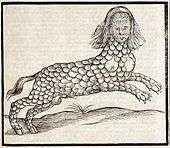
Bestiary
In Edward Topsell's History of Four-footed Beasts (1607), the lamia is described as having the upper body (i.e., the face and breasts) of a woman, but with goatlike hind quarters with large and filthy "stones" (testicles) that smell like sea-calves, on authority of Aristophanes. It is covered with scales all over.[20]
Adaptations
John Keats's Lamia in his Lamia and Other Poems is a reworking of the tale in Apollonius's biography by Philostratus, described above. In Keats's version, the student Lycius replaces Menippus the Lycian. For the descriptions and nature of the Lamia, Keats drew from Burton's The Anatomy of Melancholy.[96] August Enna wrote an opera called Lamia.[34]
English composer Dorothy Howell composed a tone poem Lamia which was played repeatedly to great acclaim under its dedicatee Sir Henry Wood at the London Promenade concerts in the 1920s. It has been recorded more recently by Rumon Gamba conducting the BBC Philharmonic Orchestra for Chandos Records in a 2019 release of British tone poems.
Modern folk traditions
In modern Greek folk tradition, the Lamia has survived and retained many of her traditional attributes.[97] John Cuthbert Lawson remarks "the chief characteristics of the Lamiae, apart from their thirst for blood, are their uncleanliness, their gluttony, and their stupidity".[98] The contemporary Greek proverb, "της Λάμιας τα σαρώματα" ("the Lamia's sweeping"), epitomises slovenliness;[98] and the common expression, "τό παιδί τό 'πνιξε η Λάμια" ("the child has been strangled by the Lamia"), explains the sudden death of young children.[98]
Later traditions referred to many lamiae; these were folkloric monsters similar to vampires and succubi that seduced young men and then fed on their blood.[99][100]
Fine arts
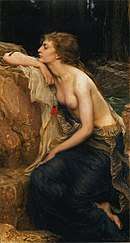
In a 1909 painting by Herbert James Draper, the Lamia who moodily watches the serpent on her forearm appears to represent a hetaera. Although the lower body of Draper's Lamia is human, he alludes to her serpentine history by draping a shed snakeskin about her waist. In Renaissance emblems, Lamia has the body of a serpent and the breasts and head of a woman, like the image of hypocrisy.
See also
Explanatory notes
- Making her the granddaughter of Poseidon. Lybie is a personification of Libya.
- The same scholium states that Mormo and Gello are equivalent to Lamia, therefore by transference Mormo is queen of the Laestrygonians, hence: Stannish & Doran (2013), p. 118.
- Horace makes a related joke, referring to the aforementioned Lucius Aelius Lamia the praetor as "Lamus", in this instance regarded as the founding figure of the city of the Laestrygonians.[18]
- This prompted Henderson (1998) to "humorlessly infer" that the Lamia must have been a hermaphrodite. Ogden (2013a), p. 91, note 117.
- Neu pransae Lamiae vivum puerum extrahat alvo (v. 340). Alexander Pope translates the line: Shall Lamia in our sight her sons devour, /and give them back alive the self-same hour?
- Begins with lower case
- This phasma is a more "generic term for creatures".[39]
- Keats's reworking makes this Lamia have serpent form for certain, which she wants to lose.
- Demetrius's father Antigonus and Demochares of Soli.
- Grandfather of his namesake, the consul Lucius Aelius Lamia (d. 33 CE).
- Or Metamorphoses, thus abbreviated "Apu. Met."
- They are not strictly speaking "witches", but they are referred to as such by convention.[50] In the Latin text, Meroe is referred to as a saga, a wise woman or soothsayer.[51]
- It has been cautioned that there may not be great import in the label "lamiae" here beyond derogatory insult,[48] and Apuleius uses the label rather indescriminately elsewhere.[54]
- The Elizabethan translator William Adlington rendered lamiae as "hags".[55]
- Incidentally, Dio in Oration 37 quotes a Sibyl's song in which the Sibyl (Libyan Sibyl) identifies her mother as Lamia (daughter of Poseidon).[68]
- Aristotle says there is a shark called "lamia".Resnick & Kitchell (2007), p. 83
- Note the snakeskin wrapped around her arm and waist.
- Lamia has human legs and a snakeskin around her waist. There is also a small snake on her right forearm.
References
Citations
- West, David R. (1995), Some cults of Greek goddesses and female daemons of Oriental origin, Butzon & Bercker, p. 293, ISBN 9783766698438
- Scholiast on Wasps, 1035.[1]
- Polomé, Edgar C.; Adams, Douglas Q. (1997). "Spirit". In Mallory, J. P.; Adams, Douglas Q. (eds.). Encyclopedia of Indo-European Culture. Taylor & Francis. p. 538.
- Johnston, Sarah Iles, ed. (2013). Restless Dead: Encounters Between the Living and the Dead in Ancient Greece. Univ of California Press. p. 174. ISBN 9-780-5202-8018-2
- Ogden (2013b), p. 98: "Because of Hera ... she lost [or: destroyed] the children she bore".
- Duris of Samos, Libyica, Book 2.[4][5]
- Duris of Samos (d. 280 B. C.), Libyca, quoted by Ogden (2013b), p. 98
- Diodorus Siculus (fl. 1st century BC), Library of History XX.41, quoted by Ogden (2013b), p. 98
- Bekker, Immanuel, ed., Diodorus Siculus, Bibliotheca Historica XX.41
- Ogden (2013b), p. 99.
- Fisher, Elizabeth A. (2009), "The Anonymous Commentary on Nicomachean Ethics VII: Language, Style and Implications", in Barber, Charles E.; Jenkins, David Todd (eds.), Medieval Greek Commentaries on the Nicomachean Ethics, Brill, pp. 147–148
- Aristotle, Nicomachean Ethics 1148b.[11]
- Scholium from the Byzantine-Hellenistic period to Aristophanes, Peace 758, quoted by Ogden (2013b), p. 98
- Bell, Robert E. (1993), Women of Classical Mythology, drawing upon Diodorus Siculus XX.41; Suidas 'Lamia'; Plutarch 'On Being a Busy-Body' 2; Scholiast on Aristophanes's Peace 757; Eustathius on Odyssey 1714)
- Heraclitus Paradoxographus (2nd century) De Incredibilibus 34, quoted by Ogden (2013b), p. 98
- Ogden (2013b), p. 98.
- Scholium to Theocritus Idylls 15.40.[16][4]
- Mulroy, D. (1994), Horace's Odes and Epodes, University of Michigan Press, p. 86, ISBN 978-0472105311
- Aristophanes, The Wasps, 1035; Peace 758, cited by Ogden (2013a), p. 91, note 117.
- Topsell, Edward (1607), "Of the lamia, The historie of foure-footed beastes.
- viz. Scholia to the passages whose annotations refer to her,[13]
- "a Lamia's groin" (Benjamin Bickley Rogers, 1874), "a foul Lamia's testicles" (Athenian Society, 1912), "sweaty Crotch of a Lamia" (Paul Roche, 2005).
- "Lamia", Suda On Line", tr. David Whitehead. 27 May 2008
- Leinweber (1994), "Witchcraft and Lamiae in 'The Golden Ass'" Folklore 105, p. 77.
- Tertullian, Against Valentinius (ch. iii)
- Ogden (2013a), pp. 90–91, note 114.
- Kilpatrick, Ross Stuart (1990). The Poetry of Criticism: Horace, Epistles II and Ars Poetica. University of Alberta. p. 80. ISBN 9780888641465.
- Member of the university (1894). A literal Translation of Horace's Art of Poetry. With explanatory notes. Cambridge. p. 22.
- "Lamia", Suda On Line", tr. David Whitehead. 1 April 2008
- Suidas (1834), Gaisford, Thomas (ed.), Lexicon: post Ludolphum Kusterum ad codices manuscriptos. K - Psi, 2, Typographeo Academico, p. 2523: "Μορμώ: λέγεται καὶ Μορμώ, Μορμοῦς, ὡς Σαπφώ. καὶ Μορμών, Μορμόνος. Ἀριστοφάνης: ἀντιβολῶ σ', ἀπένεγκέ μου τὴν Μορμόνα. ἄπο τὰ φοβερά: φοβερὰ γὰρ ὑπῆρχεν ἡ Μορμώ. καὶ αὖθις Ἀριστοφάνης: Μορμὼ τοῦ θράσους. μορμολύκειον, ἣν λέγουσι Λαμίαν: ἔλεγον δὲ οὕτω καὶ τὰ φοβερά. λείπει δὲ τὸ ὡς, ὡς Μορμώ, ἢ ἐπιρρηματικῶς ἐξενήνεκται, ὡς εἰ ἔλεγε, φεῦ τοῦ θράσους".
- Ogden (2013a), p. 91, note 114
- "Mormo", Suda On Line", tr. Richard Rodriguez. 11 June 2009.
- Hamilton, H.C.; Falconer, W. edd., Strabo, Geography I.2.8
- Skene, Bradley (2016). Lamia. The Ashgate Encyclopedia of Literary and Cinematic Monsters. Routledge. pp. 369–370.CS1 maint: ref=harv (link)
- Schmitz, Leonhard (1873), Smith, William (ed.), "La'mia", A Dictionary of Greek and Roman biography and mythology, London: John Murray, 2, pp. 713–714 Perseus Project "La'mia".
- Philostratus (1912). "25". In Honour of Apollonius of Tyana. 2. Translated by Phillimore, J. S. Clarendon Press. pp. 24–26.CS1 maint: ref=harv (link)
- This is given in the concluding paragraph of the chapter, Vit. Apollon. 4.25. Phillimore tr., p. 26.[36]
- Philostratus, Life of Apollonius 4.25, quoted by Ogden (2013a), pp. 106–107.
- Felton (2013), p. 232, n15.
- In Greek: "μία τῶν ἐμπουσῶν ἐστιν, ἃς λαμίας τε καὶ μορμολυκίας οἱ πολλοὶ ἡγοῦνται", Vit. Apollon. 4.25. Where Felton gives "mormolyces",[39] Ogden "renders as "bogey".[38]
- Stoneman, Richard (1991). Vampire. Greek Mythology: An Encyclopedia of Myth and Legend. Aquarian Press. pp. 178–179.CS1 maint: ref=harv (link): "Lamia (not the usual application of this term)".
- Ogden (2013a), p. 90.
- Ogden (2013b), p. 107.
- Schmitz, Leonhard (1849), Smith, William (ed.), "Lamia", A Dictionary of Greek and Roman biography and mythology, London: John Murray, 2, pp. 713–714 Perseus Project "La'mia (2)".
- Kapparis, Konstantinos (2017), Prostitution in the Ancient Greek World, Walter de Gruyter GmbH & Co KG, p. 118, ISBN 9783110557954
- Plutarch, Demetrius 19, Perrin, Bernadotte, ed.
- Kapparis (2017), p. 118, citing Lamia O'Sullivan, Lara (2009), pp. 53–79, esp. p. 69
- Stannish & Doran (2013), p. 117:"This is a pejorative expression, not a formal classification, but it is still meaningful"; "..labeling of a dangerous woman as a lamia was not uncommon.. Aelian records.. a notorious prostitute.. (Miscellany 12.17, 13.8)".
- Griffiths, Alan (2002), "The Odes: Just where do you draw the line?", Traditions and Contexts in the Poetry of Horace, Cambridge University Press, p. 72, ISBN 9781139439312
- Frangoulidis, Stavros (2008). Witches, Isis and Narrative: Approaches to Magic in Apuleius' "Metamorphoses". Walter de Gruyter. p. 116. ISBN 9783110210033. ISBN 9783110210033
- Apul. Met.1.8
- Apul. Met. 1.17. Leinweber (1994), p. 78: "Admittedly, Apuleius' use of the term "Lamiae" is an isolated occurrence. Elsewhere, Meroe and her sister are referred to as witches or sorcerer".
- Leinweber (1994), pp. 77, 79–81.
- Cupid refers to Psyche's sisters as Lamiae, Apul. Met. 5. 11(Stannish & Doran (2013), p. 117, note 26)
- [Apuleius] (1989), Metamorphoses, Harvard University Press
- Apul. Met. 1.12–17 (in Latin)
- Stannish & Doran (2013), pp. 115–118.
- Greek Anthology 7.154, cited by Pache (2004), pp. 72–73
- Pache (2004), p. 70.
- Ogden (2013a), p. 87.
- Statius, Thebaid, I. 562–669, quoted by Ogden (2013b), pp. 100–102; Latin text: Thebais I; Bailey, D. R. Shackleton tr. (2003) Thebaid, Book I.
- Fontenrose (1959), p. 104.
- Ogden (2013a), p. 102.
- Pausanias, translated by Jones, W.H.S.; Ormerod, H.A., Description of Greece, 1. 43. 7 - 8
- Plutarch, Moralia 1101c, cited by Ogden (2013b), p. 107.
- Dio Chrysostom, Orations, 5.1, 5–27, quoted by Ogden (2013b), pp. 103–104
- Cohoon, J. W. tr., ed. Orations 5 (Loeb Classics).
- Crosby, Henry Lamar ed., tr., Orations 37.13 (Loeb Classics).
- Scobie, Alex (1977), "Some Folktales in Graeco-Roman and Far Eastern Sources", Philologus, 121: 710, cited by Resnick & Kitchell (2007), p. 82
- Felton (2013), pp. 231–232.
- Lea, Henry Charles (1986) [1939], Materials toward a History of Witchcraft, 1, AMS Press, p. 110, ISBN 9780404184209
- Hincmar, De divortio Lotharii ("On Lothar's divorce"), XV Interrogatio, MGH Concilia 4 Supplementum, 205, as cited by Bernadotte Filotas, Pagan Survivals, Superstitions and Popular Cultures in Early Medieval Pastoral Literature (Pontifical Institute of Mediaeval Studies, 2005, p. 305.
- In his 1628 Glossarium mediae et infimae latinitatis, Du Cange made note of the geniciales feminae, and associated them with words pertaining to generation and genitalia; entry online.
- Ogden (2013b), p. 105.
- Fontenrose (1959), p. 44, as the female counterpart of the Python, also of Delphi; and passim.
- Fontenrose (1959), p. 107.
- Cook, Erwin F. (2006), The Odyssey in Athens: Myths of Cultural Origins, Cornell University Press, p. 89 ISBN 9780801473357
- Campbell, David A., tr., ed. (1991), Stesichorus, Frag 220, p. 133, and note 2. This fragment = Scholios on Apollonius Rhodius 4.828.[77]
- While Odyssey 12.124 itself says Scylla's mother was Crataeis, its scholiast mentions the non-Homeric tradition that Lamia was her mother.[77]
- Ogden (2013b), pp. 98, 99, 105: "Nothing here explicitly declares.. a serpentine element" (Duris and Scholium), p. 98; "nothing here, again, speaks directly of a serpentin nature" (Diodorus and Heraclitus Paradoxographus), p. 98.
- Stoneman (1991), pp. 178–179 "Vampire"
- Ogden (2013b), p. 102: "This is not to say that the notion of an archetypal Lamia preceded the notion of lamiai as a category of monster".
- Fontenrose (1959).
- Ogden (2013b), pp. 97, 102.
- Antoninus Liberalis (2nd century), Metamorphoses 8, paraphrasing Nicander, 2nd century B.C., quoted by Ogden (2013b), p. 105
- Fontenrose (1959), pp. 44–45.
- Fontenrose (1959), pp. 284–287.
- Odyssey 12.124 and scholia, noted by Karl Kerenyi, Gods of the Greeks 1951:38 note 71.
- Scholia to Aristophanes, Frogs 393: Rutherford, Willam G., ed. (1896), Scholia Aristophanica, 1, London: Macmillan, pp. 312–313
- Philostratus's biography identified empousa with lamia, as already given. Empusa is equated with Hecate in a fragment of Aristophanes's lost play, Tagenistae.[89]
- Ogden (2013a), p. 91.
- Ogden (2013b), p. 97.
- Candido, Igor (2010), Celenza, Christopher S. (ed.), "The Role of the Philosopher in Late Quattrocento Florence: Poliziano's Lamia and the Legacy of the Pico-Barbaro Epistolary Controversy", Angelo Poliziano's Lamia: Text, Translation, and Introductory Studies, BRILL, p. 106
- Fernández-Armesto, Felipe (2011), 1492: The Year Our World Began, p. 129 ISBN 1408809508
- Brauner, Sigrid (2001). Fearless Wives and Frightened Shrews: The Construction of the Witch in Early Modern Germany. University of Massachusetts Press. p. 123.CS1 maint: ref=harv (link) ISBN 1-5584-9297-6
- Keats made a note to this effect at the end of the first page in the fair copy he made: see William E. Harrold, "Keats' 'Lamia' and Peacock's 'Rhododaphne'" The Modern Language Review 61.4 (October 1966:579–584) p 579 and note with bibliography on this point.
- Lamia receives a section in Georgios Megas and Helen Colaclides, Folktales of Greece (Folktales of the World) (University of Chicago Prtes) 1970.
- Lawson, Modern Greek Folklore and Ancient Greek Religion: A Study in Survivals (Cambridge University Press) 1910:175ff.
- Jøn, A. Asbjørn (2003). "Vampire Evolution". METAphor (August): 19–23.
- "Information on Lamia from the Online Encyclopedia". Archived from the original on 2008-12-28. Retrieved 2009-06-06.
Bibliography
- Felton, D. (2013). "Apuleius' Cupid Considered as a Lamia (Metamorphoses 5.17–18)". Illinois Classical Studies (38): 229–244. doi:10.5406/illiclasstud.38.0229. JSTOR 10.5406/illiclasstud.38.0229.
- Fontenrose, Joseph Eddy (1959). Python: A Study of Delphic Myth and Its Origins. University of California Press.CS1 maint: ref=harv (link)
- Graves, Robert (1955). "Lamia". Greek Myths. London: Penguin. pp. 205–06. ISBN 978-0-14-001026-8.
- Kerényi, Karl (1951), The Gods of the Greeks pp 38–40. Edition currently in print is Thames & Hudson reissue, February 1980, ISBN 0-500-27048-1.
- Leinweber, David Walter (1994). "Witchcraft and Lamiae in 'The Golden Ass'". Folklore. 105: 77–82.CS1 maint: ref=harv (link) JSTOR 1260631
- Ogden, Daniel (2013-02-28). Drakon: Dragon Myth and Serpent Cult in the Greek and Roman Worlds. Oxford University Press. ISBN 9780199557325. ISBN 0199557322
- Ogden, Daniel (2013-05-30). "10 Lamia, Slain by Eurybatus and Others". Dragons, Serpents, and Slayers in the Classical and Early Christian Worlds: A Sourcebook. Oxford University Press. pp. 99–. ISBN 9780199925117. ISBN 0199323747
- Pache, Corinne Ondine, ed. (2004). "Linos and Demophone". Baby and Child Heroes in Ancient Greece. University of Illinois Press. pp. 66–77. ISBN 9780252029295.CS1 maint: ref=harv (link) ISBN 9780252029295
- Resnick, Irven M.; Kitchell, Kenneth F., Jr. (2007). "'The Sweepings of Lamia': Transformations of the Myths of Lilith and Lamia". Religion, Gender, and Culture in the Pre-Modern World. pp. 77–105. ISBN 9780230604292.
- Stannish, Steven M.; Doran, Christine M. (2013). Magic and Vampirism in Philostratus' Life of Apollonius of Tyana and Bram Stoker's Dracula. Preternature: Critical and Historical Studies on the Preternatural. 2. pp. 113–138. ISBN 9780520040915. JSTOR 10.5325/preternature.2.2.0113.CS1 maint: ref=harv (link)
External links
| Wikimedia Commons has media related to Lamia (mythology). |